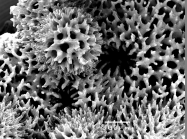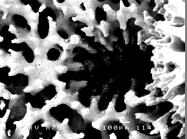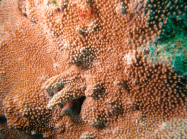
| Intro | | About | | Wiki | | Search traits | | Data explorer | | Literature | | Definitions | | Sources | | Webservices | | Statistics | | Feedback | | Editors | | Log in |
WoRMS taxon detailsMontipora Blainville, 1830
203834 (urn:lsid:marinespecies.org:taxname:203834)
accepted
Genus
Montipora verrucosa (Lamarck, 1816) (type by subsequent designation)
Manopora Dana, 1846 · unaccepted > junior subjective synonym
marine,
de Blainville, H. M. (1830). Zoophytes. In: Dictionnaire des sciences naturelles, dans lequel on traitre méthodiquement des differéns êtres de la nature, considérés soit en eux-mêmes, d'après l'état actuel de nos connoissances, soit relativement à l'utlité qu'en peuvent retirer la médicine, l'agriculture, le commerce et les arts. Edited by F. G. Levrault. Tome 60. Paris, Le Normat. Pp. 548, pls. 68. <em>Paris, 1830.</em> 60 : 1-546., available online at https://www.biodiversitylibrary.org/page/25318344 [details]
Description This genus is distinctive within the Acroporidae because of the variety of coenosteal ornamentations developed (variously...
Description This genus is distinctive within the Acroporidae because of the variety of coenosteal ornamentations developed (variously known as papillae, tuberculae, ridges, nodules, etc) and the way in which these are combined and distributed around and between corallites in different species. Although corallites are immersed within the coenosteum, the arrangement of coenosteal structures (usually papillae or tuberculae) around corallites in some species gives the impression of a theca. Some species are without coenosteal ornatmentation ("glabrous") and these are distinguished by corallite size, colony form and other associated diferences. Colonies of Montipora are usually indeterminate in growth and individual species and colonies within species can exhibit some or all of the range of growth forms. [details] Description Colonies are submassive, laminar, foliaceous, encrusting or branching. Corallites are very small. Septa are in two cycles...
Description Colonies are submassive, laminar, foliaceous, encrusting or branching. Corallites are very small. Septa are in two cycles with inward-projecting teeth. Columellae are absent. Corallite walls and the coenosteum are porous and may be highly elaborated. Polyps are usually extended only at night (Veron, 1986). Commonly forms plates or encrusting sheets, but also several other forms. Distinguished by its deep, tiny corallites (<1mm across) separated by porous walls. Since the corallites lack virtually any features, identification to species level is very difficult. When forming plates, corallites occur on both surfaces (Richmond, 1997). [details]
Hoeksema, B. W.; Cairns, S. (2025). World List of Scleractinia. Montipora Blainville, 1830. Accessed through: World Register of Marine Species at: https://www.marinespecies.org/aphia.php?p=taxdetails&id=203834 on 2025-07-16
Date action by 2000-09-28 07:24:50Z changed Garcia, Maria 2006-09-25 06:54:45Z changed Martinez, Olga
Nomenclatureoriginal description
de Blainville, H. M. (1830). Zoophytes. In: Dictionnaire des sciences naturelles, dans lequel on traitre méthodiquement des differéns êtres de la nature, considérés soit en eux-mêmes, d'après l'état actuel de nos connoissances, soit relativement à l'utlité qu'en peuvent retirer la médicine, l'agriculture, le commerce et les arts. Edited by F. G. Levrault. Tome 60. Paris, Le Normat. Pp. 548, pls. 68. <em>Paris, 1830.</em> 60 : 1-546., available online at https://www.biodiversitylibrary.org/page/25318344 [details] original description (of Manopora Dana, 1846) Dana, J.D. (1846-1849). Zoophytes. United States Exploring Expedition during the years 1838-1842. <em>Lea and Blanchard, Philadelphia.</em> 7: 1-740, 61 pls. (1846: 1-120, 709-720; 1848: 121-708, 721-740; 1849: atlas pls. 1-61)., available online at https://www.biodiversitylibrary.org/page/18989497, http://www.sil.si.edu/digitalcollections/usexex/navigation/ScientificText/USExEx19_08select.cfm [details] basis of record Veron JEN. (1986). Corals of Australia and the Indo-Pacific. <em>Angus & Robertson Publishers.</em> [details] Otheradditional source
Neave, Sheffield Airey. (1939-1996). Nomenclator Zoologicus vol. 1-10 Online. <em>[Online Nomenclator Zoologicus at Checklistbank. Ubio link has gone].</em> , available online at https://www.checklistbank.org/dataset/126539/about [details]
additional source Randall RH. (2003). An annotated checklist of hydrozoan and scleractinian corals collected from Guam and other Mariana Islands. <em>Micronesica.</em> 35-36: 121-137. page(s): 129 [details] additional source Robertson R. (1970). Review of the predators and parasites of stony Corals, with special reference to symbiotic Prosobranch Gastropods. <i>Pacific Science 24 (1)</i>: 43-54 page(s): 45, 46, 48 [details] additional source Liu, J.Y. [Ruiyu] (ed.). (2008). Checklist of marine biota of China seas. <em>China Science Press.</em> 1267 pp. (look up in IMIS) [details] Available for editors additional source Benzoni, F., Stefani, F., Pichon, M., Galli, P. 2010. The name game: morpho-molecular species boundaries in the genus Psammocora (Cnidaria, Scleractinia). Zoological Journal of the Linnean Society 160: 421-456., available online at https://doi.org/10.1111/j.1096-3642.2010.00622.x page(s): 422, 437, 449 [details] Available for editors additional source Veron JEN. (2000). Corals of the World. Vol. 1–3. <em>Australian Institute of Marine Science and CRR, Queensland, Australia.</em> [details] additional source Claereboudt, M.R. 2006. Porites decasepta: a new species of scleractinian coral (Scleractinia, Poritidae) from Oman. Zootaxa 1188: 55-62., available online at http://www.mapress.com/zootaxa/2006f/z01188p062f.pdf page(s): 55 [details] additional source Yabe H, Sugiyama T. (1935). Revised list of the reef-corals from the Japanese seas and of the fossil reef corals of the raised reefs and the Ryukyu limestone of Japan. <em>Journal of the Geological Society of Japan.</em> 42: 379-403. page(s): 385, 387, 399 [details] additional source Cairns, S.D., L. Gershwin, F.J. Brook, P. Pugh, E.W. Dawson, O.V. Ocaña, W. Vervoort, G. Williams, J.E. Watson, D.M. Opresko, P. Schuchert, P.M. Hine, D.P. Gordon, H.I. Campbell, A.J. Wright, J.A.Sánchez & D.G. Fautin. (2009). Phylum Cnidaria: corals, medusae, hydroids, myxozoans. <em>in: Gordon, D.P. (Ed.) (2009). New Zealand inventory of biodiversity: 1. Kingdom Animalia: Radiata, Lophotrochozoa, Deuterostomia.</em> :59-101., available online at https://repository.si.edu/handle/10088/8431 [details] Available for editors additional source Cairns, S.D., R. Baron-Szabo, A.F. Budd, B. Lathuilière, E. Roniewicz, J. Stolarski & K.G. Johnson. (2010). Corallosphere. , available online at http://www.corallosphere.org [details] additional source Veron JEN, Wallace CC (1984) Scleractinia of Eastern Australia – Part V. Family Acroporidae. Australian Institute of Marine Science Monograph Series 6: 1–485. [details] additional source Bassett-Smith, P.W. (1890). Report on the corals from Tizard and Macclesfield Banks, China Sea. <em>Annals and Magazine of Natural History,.</em> 6(35): 353-374, 443-458, pls. 12-14., available online at https://doi.org/10.1080/00222939008694050 page(s): 360, 450-451 [details] additional source Duncan PM (1884) A revision of the families and genera of the sclerodermic Zoantharia, Ed. & H., or Madreporaria (M. Rugosa excepted). Journal of the Linnean Society of London, 18: 1-204. [details] additional source Veron JEN, Marsh LM. (1988). Hermatypic corals of Western Australia : records and annotated species list. <em>Records Western Australian Museum Supplement.</em> 29: 1-136., available online at https://doi.org/10.5962/bhl.title.60555 page(s): 32, 47 [details] additional source Durham JW. (1962). Corals from the Galapagos and Cocos Islands. <em>Proceedings of the California Academy of Sciences, Fourth Series.</em> 32 (2): 41-56. page(s): 45 [details] additional source den Hartog, J. C. (1997). The sea anemone fauna of Indonesian coral reefs. Periplus Editions. Republic of Singapore., chapter Box 8.2, volume 7, pp. 351-370 page(s): 356 [details] additional source Maragos, J. E.; Molina, M.; Kenyon, J. (2004). Palmyra Atoll coral data compiled from Townsend Cromwell 2000-2002, U.S. Fish and Wildlife Service 2000-2001, and Sette 2004 surveys [Table 8]. UNPUBLISHED, UNPUBLISHED [details] additional source Maragos, J. E.; Kenyon, J. (2004). Rose Atoll coral data compiled from US Fish and Wildlife Service 1994, Townsend Cromwell 2002, and Sette 2004 surveys [Table 10]. UNPUBLISHED, Unpublished page(s): 1 [details] additional source Ono, S.; Reimer, J. D.; Tsukahara, J. (2007). Thriving cnidarian community on the volcanic coastline of Sakurajima Taisho Lava Field, southern Japan. Coral Reefs, 26, 95 page(s): 95 [details] additional source Dunn, D. F. (1982). Cnidaria. McGraw-Hill Book Company. New York and other cities., volume 1, pp. 669-706 page(s): 701 [details]  Present Present  Inaccurate Inaccurate  Introduced: alien Introduced: alien  Containing type locality Containing type locality
Nontype BMNH, geounit Chinese Exclusive Economic Zone [details]
Nontype BMNH, geounit Chinese Exclusive Economic Zone [details]
Nontype BMNH, geounit Taiwanese Exclusive Economic Zone [details]
Nontype UWA 859-87, geounit Australian Exclusive Economic Zone [details]
Nontype WAM 26-87, geounit Australian Exclusive Economic Zone [details]
Nontype WAM 29-87, geounit Australian Exclusive Economic Zone [details]
Nontype WAM 906-81, geounit Australian Exclusive Economic Zone [details]
From editor or global species database
Comparison Anacropora fits within the above description: it is exclusively ramose and without coenosteal ornamentation. Molecular studies indicate the two genera should be combined (see Fukami, H., Omori, M. and Hatta, M. (2000) Phylogenetic relationships in the coral family Acroporidae, reassessed by inference from the mitochondrial genes. Zoological Sciences 17, 689-696). [details]Description This genus is distinctive within the Acroporidae because of the variety of coenosteal ornamentations developed (variously known as papillae, tuberculae, ridges, nodules, etc) and the way in which these are combined and distributed around and between corallites in different species. Although corallites are immersed within the coenosteum, the arrangement of coenosteal structures (usually papillae or tuberculae) around corallites in some species gives the impression of a theca. Some species are without coenosteal ornatmentation ("glabrous") and these are distinguished by corallite size, colony form and other associated diferences. Colonies of Montipora are usually indeterminate in growth and individual species and colonies within species can exhibit some or all of the range of growth forms. [details] Diagnosis Acroporidae which are submassive, foliaceous, ramose or encrusting; no axial corallite; corallite wall porous; columella feeble or absent; coenosteum reticular with strong vertical trabeculae, thin horizontal connections; surface spinulose or hirsute; no diseppiments [details] Remark Monographed by Bernard, H. M. 1897 The genus Montipora. The genus Anacropora. Catalogue of Madreporarian corals in the British Museum (Natural History) 3: 1-192, plates 1-34. Monographed from eastern Australia by Veron, J.E.N. and Wallace, C.C. 1984 Scleractinia of Eastern Australia. Part V. Family Acroporidae.Australian Institute of Marine Science Monograph Series 6, pp. 485: ANU Press, Canberra. [details] Unreviewed
Authority Authority given as Quoy & Gaimard, 1830 in Faure (1977). Type species: Porites verrucosa Lamarck, 1816 (Veron, 1986). [details]Description Colonies are submassive, laminar, foliaceous, encrusting or branching. Corallites are very small. Septa are in two cycles with inward-projecting teeth. Columellae are absent. Corallite walls and the coenosteum are porous and may be highly elaborated. Polyps are usually extended only at night (Veron, 1986). Commonly forms plates or encrusting sheets, but also several other forms. Distinguished by its deep, tiny corallites (<1mm across) separated by porous walls. Since the corallites lack virtually any features, identification to species level is very difficult. When forming plates, corallites occur on both surfaces (Richmond, 1997). [details]
|



